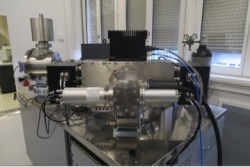Lab
Scientific Infrastructure

Lowest-blank clean room facility for isotope analysis of accessory mineral grains
The class 100 clean-air facility is used for the chemical preparation of mineral grains for high-precision U-Pb geochronology, and trace element and Hf isotope analysis. Lowest levels of procedural Pb blanks allow precise isotope analysis of 1 pg of Pb from a variety of minerals (zircon, baddeleyite, monazite, xenotime, titanite, rutile, apatite) that have been dissolved previously in acids using Parr digestion vessels. All acids employed for U-Pb chemistry are distilled in-house and have blank levels of 100 fg Pb/ml or less. The laboratory is using Earthtime 205Pb-233U-235U and 202Pb-205Pb-233U-235U tracer solutions. Quality assessment is carried out by repeated analysis of Earthtime synthetic solutions (ET100, ET500, ET2000) as well as zircon reference materials, such as Plesovice, Temora, R33, GJ-1 and others.

Mineral separation and preparation facility
Samples are crushed manually or in a jaw-crusher, milled to <350µm size, washed and separated using a Wilfely shaking table, methylene iodide heavy liquids and Frantz magnetic separators. Final selection is done under binoculars ; most of analyzed grains are imaged by cathodo-luminescence or back-scattered electrons using the scanning electron microscope in-house, and undergo chemical abrasion prior to dissolution.

Thermal ionization mass spectrometry
The mass spectrometry lab features two pieces of equipment :
- A TRITON thermal ionisation mass spectrometer from Thermo Scientific, purchased in 2005. It is equipped with 1011 and 1112 Ohm resistance faraday cups and a MasCom discrete-dynode secondary electron multiplier used in pulse-counting mode, which is demonstrated to be linear up to 1.3 Mcps.
- A PHOENIX thermal ionisation mass spectrometer from IsotopX, purchased in 2016. It is equipped with 1112 Ohm resistance faraday cups and a Daly-based ion-counting system using a Hamamatsu photo-multiplier, demonstrated to be linear up to 2.5 Mcps. The equipment allows measurement of low levels of radiogenic lead via a multidynamic procedure using the high-resistance faraday cups or, alternatively, the Daly ion counting system.
The two mass spectrometers are intercalibrated at the level of 0.01% for 206Pb/238U dates.
